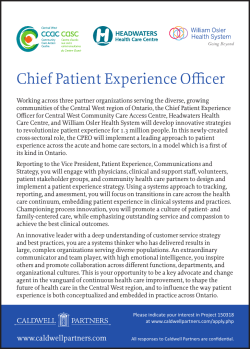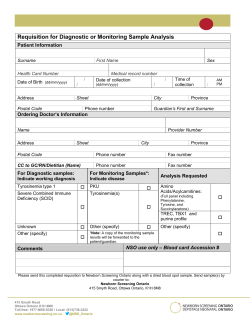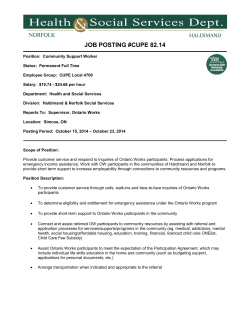
made a presentation
Consultations on University Funding Reform Presentation to Ontario Confederation of University Faculty Associations May 9th, 2015 Sue Herbert Executive Lead Bill Praamsma Project Director What are We Doing? • The Ministry launched an open and transparent consultation on university funding reform, based on achieving the following principles: – – – – Enhanced quality and improving student experience. Support for the existing differentiation process. Financial sustainability. Increased transparency and accountability. • The scope of the consultation is the allocation of Ministry of Training, Colleges and Universities (MTCU) operating grants, which totaled $3.5 billion in 2014-15. 2 General Funding Approaches • Each year, the Government of Ontario allocates funding for operating grants to the Ministry of Training, Colleges and Universities through the provincial budget process. The Ministry must, in turn, distribute this to universities. • Past literature scans have revealed a wide range of funding policies in use across jurisdictions and universities, with no consistent pattern of movement towards a single model. (Source: MTCU) Formula Based Approach Funding distributed through a formally defined procedure, based on data that can be used to allocate funding to a system, determine the funding requirements of a system, or both. Example Ontario University funding model IncrementalBudget Performance Based Zero Based Activity Based Funding starts with the current budget and adds or subtracts from it to arrive at the coming period’s expenditures. Allocates funding related to activities and results (outcomes). Specific outcome measures are defined on a quantitative or qualitative basis. Focuses on the individual program or activity, assuming no budgets from prior years; instead, each year’s budget begins at a base of zero. Funds generated by a specific activity flow through to organizations, with those organizations bearing responsibility for all costs and income generated. Fixed or block grant approach, capital investments. Key Performance Indicators Program reviews, peer-reviewed research funding No provincial example. 3 Ontario’s Current Model • Ontario’s Strategic Mandate Agreements reflected a stewardship approach by the Ministry (within the context of an autonomous university system). • Current formula funding in Ontario is used determine the share of funding allocated to institutions within a university system on a consistent, predictable, and comprehensible policy basis. – This approach to formula funding is aligned with practice in other jurisdictions. Formula models do not typically determine the amount of funding in the system. • Changes to funding model design do not address the question of adequacy of funding in the system, or issues arising from governance. 4 Ontario’s Current Model • Ontario's current formula model is primarily enrolment, based, with elements of performance and special purpose funding. MTCU Operating Grants to Ontario Universities, 2014-15 Core Model: Enrolment Based Funding Performance Funding Undergraduate Accessibility Grant $170.2M, (5%) General Quality Grant and Performance $154.3M (4%) Special Purpose and Other Grants Basic Operating Grant $2,669M, (77%) Northern Ontario Grant, $16.0M, (0.5%) Graduate Expansion Grant* $97.3M, (3%) Institution Specific Grants, $31.8M, (1%) Other Grants, $89.9M, (3%) Medical & Nursing Related $150.2M, (4%) Access (First Gen, Bilingualism, Aboriginal, Disabilities), $100.0M, (3%) 5 Ontario University Revenue • Ministry grants accounted for 40% of university operating revenue in 2013-14, with regulated student fees accounting for 42% and international tuition fees accounting for 10%. • This revenue balance has implications for the potential impacts of changes to funding policy. Operating Revenue of Ontario Unviersities, By Source for 2013-14 Investment Income, 5% Ancillary Fees, 6% Donations & Other, 1% International Tuition Fees, 10% MTCU Grants, 40% Domestic Tuition Fees, 36% Other Ontario Grants, 2% 6 Why Change? • The current model is focused on one activity (enrolment) and does not meaningfully reflect other significant institutional activities, research or student outcomes, or teaching quality. • Although some grants are insensitive to enrolment, it does not have a dedicated revenue stabilizer for universities that may face declining enrolment. • It is complex – more complex than is necessary to provide predictable, equitable funding. – Investments and incremental funding supports are often embedded in a number of different grants making it difficult to assess equity and effectiveness. • It is based on a “total revenue” approach, which has become outdated. Removal of archaic features, such as formula fees (proxies for tuition revenue), would simplify the model, and improve transparency and accountability. 7 What We’ve Heard From You Quality & Student Experience Financial Sustainability • Student Centred: Funding must be responsive to the number of students enrolled • Adequacy: Public funding for universities must provide adequate resources to support a high quality and affordable higher education sector. • Supportive of Good Jobs: Universities should receive adequate funding to support good jobs on their campuses. • Stable and Predictable: Mechanisms should be put in place to ensure that funding is stable and predictable to facilitate long-term planning and to avoid extreme fluctuations in institutional revenue. Differentiation Transparency and Accountability • • Committed to Core Activities: Funding formula should protect and promote the two core activities of a university: world class teaching and research. • Transparent: Any formula for allocating funding must be transparent, simple to administer and objective. It should not be arbitrary or open to manipulation or negotiations behind closed doors. Above all, university funding must not be subject to short-term political objectives. Respectful of Institutional Autonomy and Academic Freedom: Any funding formula must respect institutions’ and professors’ ability to pursue strategies that enable them to do what they do best. 8 Source: OCUFA Funding Formula Review Principles Accessed: http://ocufa.on.ca/blog-posts/universities-blog-posts/ocufa-releases-principles-for-the-ontario-university-funding-formula-review/ Model Design • • Based on your principles, we have some further questions: • Student-Centred: Beyond ensuring that funding is responsive to student numbers, how could the formula be more student centred? • Committed to Core Activities: How could the funding model best support research and teaching, while recognizing that the mix of these two activities differs across universities and departments? • Stable and predictable: What operating conditions would support a stable cost structure for universities, particularly in a period of moderating enrolment? • Transparent and Respectful of Institutional Autonomy: What transparency and accountability measures could be collected from universities that would achieve an appropriate balance between institutional autonomy, and government stewardship? We invite OCUFA to submit ideas on how a reformed Ontario funding model could be designed and implemented. 9 Reference Group • In addition to our primary stakeholders, we will be consulting a small group of experts in postsecondary education and transformation in other related sectors throughout the consultation process. • Current reference group members include: • Tony Chambers – Associate Professor, OISE • Catherine Chandler-Chrichlow – Toronto Financial Services Alliance • Glenn Craney – ONCAT • Harvey Weingarten – HEQCO • David Trick – David Trick & Associates • Alastair Summerlee – Former President, University of Guelph • Alex Usher – Higher Education Strategy Associates • Mary Jo Haddad – Former CEO, Sick Kids Hospital • Along with all other elements of the consultation, input received from reference group members will be summarized at the end of the consultation. 10 Contact Information • We have a website where you may submit answers to the questions posed in the consultation guide, and any other thoughts relevant to funding model reform: • http://ontario.ca/fundinguniversities • Submissions can be emailed to FundingModel@ontario.ca. • Please feel free to contact us with further questions or information. 11
© Copyright 2025









